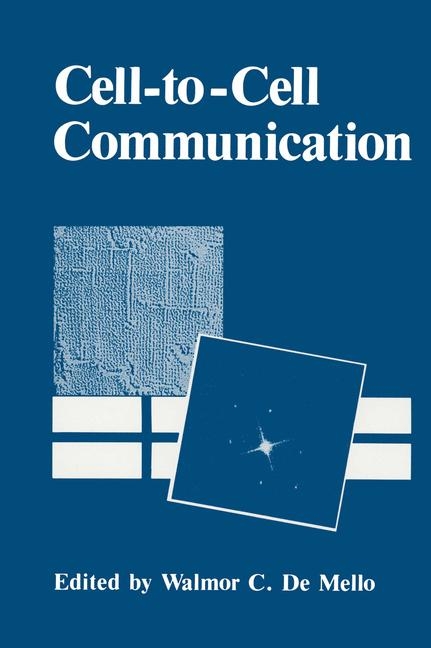
Cell-to-Cell Communication
Kluwer Academic/Plenum Publishers (Verlag)
978-0-306-42623-0 (ISBN)
- Titel ist leider vergriffen;
keine Neuauflage - Artikel merken
1 Gap Junction Structure.- 1. Introduction.- 2. Classification of Gap Junctions.- 3. Morphological Characterization of Type I Gap Junctions.- 3.1. Conventional Electron Microscopy.- 3.2. Quaternary Organization of the Gap Junction Channel.- 3.3. Possible Conformational Changes Involved in Gating.- 4. Morphological Characterization of Type II Gap Junctions.- 5. Morphological Characterization of Type III Gap Junctions.- 6. Conclusions.- 7. References.- 2 Modulation of Junctional Permeability.- 1. Introduction: Physiological Considerations.- 2. Are Gap Junctions Really Involved in Cell-to-Cell Communication?.- 3. Junctional Permeability.- 3.1. On the Regulation of Junctional Permeability.- 3.2. Na/Ca Exchange and Metabolic Inhibitors Alter the Electrical Coupling.- 3.3. Is Calcium a Physiological Modulator of Junctional Permeability?.- 3.4. Influence of Protons on Cell-to-Cell Communication.- 3.5. Cyclic AMP—A Physiological Regulator of Junctional Permeability?.- 4. Synaptic Transmission and Cell-to-Cell Coupling.- 5. Voltage Dependence.- 6. Antibodies.- 7. Influence of Temperature on gj.- 8. Pathological Implications of Junctional Conductance.- 8.1. Increased Junctional Resistance—A Cause for Slow Conduction, Reentry, and Cardiac Arrhythmias.- 8.2. Uncoupling Leads to Decreased Strength of Heartbeat.- 9. Conclusions.- 10. References.- 3 Permeability and Regulation of Gap Junction Channels in Cells and in Artificial Lipid Bilayers.- 1. Introduction.- 2. Evidence for Cell-to-Cell Channels at Gap Junctions.- 2.1. Structural Data.- 2.2. Structure-Function Studies.- 2.3. Data from Intracellular Injection of Antibodies to Gap Junctions.- 2.4. Junctional Proteins Make Channels in Artificial Lipid Systems.- 3. Cell-to-Cell Channel Gating and Permeability Modulation.- 3.1. Uncouplers.- 3.2. Uncoupling Intermediates.- 4. References.- 4 Electrotonic Coupling in the Nervous System.- 1. Introduction.- 2. Electrotonic Inhibition.- 3. Modulation of Electrotonic Coupling.- 3.1. Voltage-Dependent Gating (Rectification).- 3.2. Extrajunctional Membrane Effects (Functional Decoupling).- 3.3. Frequency Modulation (Filtering).- 3.4. Cytoplasmic and Neurohumoral Factors.- 3.5. Development and Regeneration.- 4. Experimental Determination of Electrotonic Coupling.- 4.1. Alternative Mechanisms of Intercellular Communication.- 4.2. Morphology.- 4.3. Electrophysiology.- 4.4. Dye Coupling.- 4.5. Metabolic Coupling.- 4.6. Pharmacology.- 5. Conclusion.- 6. References.- 5 Gap Junctions in Smooth Muscle.- 1. Introduction.- 2. Cell-to-Cell Junctions in Smooth Muscle.- 3. Do All Smooth Muscle Cells Have Gap Junctions?.- 3.1. Recognition of Gap Junctions in Smooth Muscle.- 3.2. Necessity of Gap Junctions for Coupling in Smooth Muscle.- 4. Regulation of Gap Junctions in Smooth Muscle.- 4.1. Myometrium: Control of Synthesis of Gap Junctions.- 4.2. Trachea.- 5. Conclusions.- 6. References.- 6 Cell Communication and Growth.- 1. Introduction.- 2. Basic Principles.- 2.1. Gap Junctions.- 2.2. Cell Proliferation.- 3. Possible Effects of Gap Junctions on Different Phases of the Cycle.- 3.1. G1 (GO)-Phase.- 3.2. S-Phase.- 3.3. G2-Phase.- 3.4. M-Phase.- 4. Evidence for Gap Junction Involvement in Control of Proliferation.- 4.1. Normal Cells.- 4.2. Cells Deficient in Growth Control.- 5. Conclusions and Future Considerations.- 6. References.- 7 Intercellular Communication in Embryos.- 1. Introduction.- 2. The Oocyte.- 2.1. Oocyte Gap Junctions.- 2.2. The Control of Oocyte Maturation.- 3. Early Cleavage Stages.- 3.1. The Occurrence of Gap Junctions, Electrical Coupling, and Dye Coupling.- 3.2. Patterns of Communication in the Early Amphibian Embryo.- 4. Early Events in Development.- 4.1. Communication and Cell Determination in the Molluscan Embryo.- 4.2. Communication and Compaction in the Early Mouse Embryo.- 5. Compartments, Gradients, and Gap Junctions.- 5.1. Communication across Insect Compartment Borders.- 5.2. Communication in Insect Imaginal Disks.- 5.3. Communication in the Early Mouse Embryo.- 5.4. Gap Junctions and Gradients.- 6. Restriction of Communication Later in Development.- 6.1. Gap Junctional Uncoupling in Neural Tissues.- 6.2. Gap Junctional Uncoupling in Muscle Development.- 7. Using Antibodies to Explore the Role of Junctions in Development.- 8. Conclusions.- 9. References.- 8 Mechanisms of Cell-to-Cell Communication Not Involving Gap Junctions.- 1. Chemical Communication between Cells.- 2. On the Release of Neurotransmitters.- 3. Cell-to-Cell Communication through the Extracellular Space.- 3.1. Electrical Interaction between Cells.- 3.2. Nerve Growth Factor—An Example of Chemical Communication between Cells.- 3.3. A Trophic Factor Controls Skeletal Muscle Properties.- 3.4. Skeletal Muscle Properties Are Dependent on the Motor Neuron Type.- 3.5. Do Postsynaptic Cells Induce Changes in the Presynaptic Neuron?.- 3.6. Neural Death during Development.- 3.7. Cellular Slime Molds: Starvation Induces Communication.- 4. References.- 9 Cell-to-Cell Communication in Salivary Glands.- 1. Introduction.- 2. Anatomy.- 2.1. Appearance of Salivary Glands.- 2.2. Morphology.- 3. Electrical Evidence.- 3.1. Current-Clamp Studies on Intact Glands.- 3.2. Current-Clamp Studies on Cell Pairs.- 3.3. Voltage-Clamp Studies on Cell Pairs.- 3.4. Insect Development and Intercellular Coupling.- 4. Diffusional Evidence.- 4.1. Static Approach.- 4.2. Dynamic Approach.- 5. Pharmacology.- 5.1. Electrical Measurements on Intact Glands.- 5.2. Diffusional Studies on Intact Glands.- 5.3. Complications Due to Changes in Membrane Potential.- 5.4. Electrical Measurements on Cell Pairs.- 6. Physiological Role of Intercellular Coupling.- 7. Conclusions.- 8. References.- 10 Intercellular Communication in Arthropods: Biophysical, Ultrastructural, and Biochemical Approaches.- 1. Introduction.- 2. Detection and Analysis of Low-Resistance Pathways.- 2.1. Coupling Ratio.- 2.2. Cable Analysis.- 2.3. Ionic Coupling in Cell Sheets.- 2.4. Specificity of Cell-Cell Coupling.- 2.5. Modulation of Coupling.- 3. Junctional Permeability to Molecular Tracers.- 3.1. Fluorescent Tracers.- 3.2. Channel Diameter.- 3.3. Kinetic Analysis of Tracer Diffusion.- 4. Ultrastructure of Arthropod Gap Junctions.- 4.1. Thin Sections.- 4.2. Freeze-Fracture.- 4.3. Ultrastructure in Different States of Conductance.- 5. Isolation and Biochemical Characterization of Gap Junctions.- 5.1. Isolation of Vertebrate Gap Junctions.- 5.2. Enrichment of Arthropod Cell Junctions.- 5.3. Biochemical Analysis of Arthropod Gap Junctions.- 5.4 Pseudo-Gap Junctions.- 6. Summary and Prospectives.- 7. References.
| Erscheint lt. Verlag | 31.10.1987 |
|---|---|
| Zusatzinfo | 388 p. |
| Verlagsort | New York |
| Sprache | englisch |
| Gewicht | 890 g |
| Themenwelt | Naturwissenschaften ► Biologie ► Genetik / Molekularbiologie |
| Naturwissenschaften ► Biologie ► Zoologie | |
| ISBN-10 | 0-306-42623-4 / 0306426234 |
| ISBN-13 | 978-0-306-42623-0 / 9780306426230 |
| Zustand | Neuware |
| Haben Sie eine Frage zum Produkt? |
aus dem Bereich


